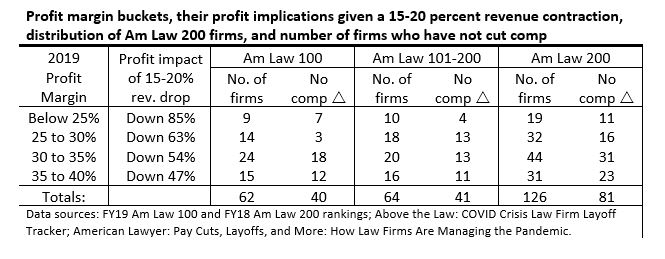Why More Firms Should Cut Salaries Sooner Rather Than Later
As we approach the end of April, firms are running out of time to materially reduce 2020 costs, Hugh A. Simons writes. Salary cuts have appeal not just because compensation comprises about two-thirds of total cost, but also because they deliver immediate savings.
April 27, 2020 at 03:36 PM
6 minute read
The original version of this story was published on The American Lawyer
 (Photo: Andrey_Popov/Shutterstock.com)
(Photo: Andrey_Popov/Shutterstock.com)
The consensus estimate for 2020 revenue is a decline of 15 to 20 percent from last year. And yet, as of April 26, less than a quarter of the Am Law 200 have reduced salaries or laid off personnel. This feels like a sluggish response given what the partner profit implications might be. A simple analysis supports this intuition.
There are 126 Am Law 200 firms who face declines in profit of a half or more under such a revenue contraction (with costs contained at last year's level). There has been no reported action to reduce comp, law firms' dominant cost item, at 81 of these firms. Even allowing for noise in the numbers, there are a lot of commercially-strong partners who are being expected to endure eye-catching drops in compensation. Some will be lured away to firms that are performing more strongly either because of practice mix or faster movement on cost reduction. Partner departure numbers, low at first, will snowball at some firms. A quick back-of-the-envelope calculation indicates we can expect to see 10 to 15 firms fold.
Analysis
The analysis looks at the effect of revenue decline on profitability through the lens of profit margin, that is: profits as a percent of revenue. It works as follows: if last year a firm had a profit margin of 50 percent and this year revenue falls by 10 percent then, with costs held at last year's level, profits would fall to 40 percent of prior year revenue—a 20 percent drop (from 50 to 40 percent of last year's revenue).
The table below applies this framework to the Am Law 200. Each row corresponds to a particular range, or 'bucket', of 2019 profit margin. The second column shows the change in profitability from 2019 to 2020 for firms in each bucket if revenues fall by the consensus estimate of 15 to 20 percent (and costs held flat). For firms in the 35 to 40 percent bucket, profits would fall by 47 percent from their 2019 level, i.e. they'd essentially be halved; firms in the lower buckets would see greater, and some stunning, declines.

The surprise here is not the scale of profit contraction; law is, after all, a largely fixed cost business. Rather, the surprise is the number of firms who have not moved to cut compensation. As the rightmost two columns of the table show, there are 126 Am Law 200 firms with 2019 profit margins in the 35-to-40 percent bucket and below; of these, 81 firms have not had salary reductions or layoffs. This dynamic applies equally to Am Law 100 and 'second hundred' firms. As the middle columns of the table show: 62 and 64 Am Law 100 and second hundred firms, respectively, face profit declines of a half and more, of which 40 and 41, respectively, have not reduced comp.
An aside on cost: law firms often describe their cost cutting as reductions from budgeted levels. The reason for this is that there's a momentum to cost growth—associates move up a year in salary, staff get annual 'merit' increases, rents have escalation clauses, medical insurance costs rise, last-year's hires now incur full-year costs. To improve the profit outlook scenarios above, costs have to go below 2019 levels. This is particularly a challenge because momentum growth is exacerbated by voluntary attrition having basically stopped. As we approach the end of April, firms are running out of time to materially reduce 2020 costs. Salary cuts have appeal not just because comp comprises about two-thirds of total cost (and of the remaining third, more than half is rent and depreciation) but also because they deliver immediate savings (unlike layoffs which entail severance payments).
Implications
How can it be that so many at-risk firms have not moved to cut compensation? First, a couple of caveats on the analysis: some firms' compensation cuts may have gone unreported; for others, their particular business mix may objectively support a stronger revenue outlook. It could also be that firm leaders are articulating greater revenue declines than they truly anticipate. Even allowing for these moderations, it has to be that the lack of movement on compensation at many firms is because partners have said they're prepared to take the hit.
It's unclear that partners will stick to these avowals. As the shock of the pandemic's onset recedes in memory, the prevailing soft demand environment will come to be accepted as a sort of normal. Partners at struggling firms will watch peers at rivals doing significantly better (due to business mix or earlier compensation cuts). Competitors will start calling commercially-strong partners, enticing them to move. Partners won't leave because their firm is having a bad year in the midst of the pandemic; it'll be reframed in their minds: they're leaving because of loss of confidence in leadership, concern about capital accounts, or desire to be part of a winning team. They'll see partners at other firms, and then at their own, move laterally; they won't want to be left behind. It's not the profit drop that imperils firms, it's the partner departures its prospect precipitates.
I don't see how all 81 of the low-margin, no-comp-cut, firms can survive. Let's say either the data are wrong, or the revenue outlook is stronger, for a half of these firms. That would mean 40 firms come under partner departure pressure. If departures take hold at, say, just a third of these firms then, in round numbers, ten to fifteen firms will go under.
Absent significant movement, and soon, this will not end well.
Hugh A. Simons is formerly a senior partner and executive committee member at The Boston Consulting Group and chief operating officer and policy committee member at Ropes & Gray. Early retired, he now researches and writes about the business side of law firms and does some consulting for old friends. He welcomes reader reactions at [email protected].
This content has been archived. It is available through our partners, LexisNexis® and Bloomberg Law.
To view this content, please continue to their sites.
Not a Lexis Subscriber?
Subscribe Now
Not a Bloomberg Law Subscriber?
Subscribe Now
NOT FOR REPRINT
© 2025 ALM Global, LLC, All Rights Reserved. Request academic re-use from www.copyright.com. All other uses, submit a request to [email protected]. For more information visit Asset & Logo Licensing.
You Might Like
View All
KPMG Wants to Provide Legal Services in the US. Now All Eyes Are on Their Big Four Peers


Sullivan & Cromwell Signals 5-Day RTO Expectation as Law Firms Remain Split on Optimal Attendance
Law Firms Mentioned
Trending Stories
- 1'It's Not Going to Be Pretty': PayPal, Capital One Face Novel Class Actions Over 'Poaching' Commissions Owed Influencers
- 211th Circuit Rejects Trump's Emergency Request as DOJ Prepares to Release Special Counsel's Final Report
- 3Supreme Court Takes Up Challenge to ACA Task Force
- 4'Tragedy of Unspeakable Proportions:' Could Edison, DWP, Face Lawsuits Over LA Wildfires?
- 5Meta Pulls Plug on DEI Programs
Who Got The Work
Michael G. Bongiorno, Andrew Scott Dulberg and Elizabeth E. Driscoll from Wilmer Cutler Pickering Hale and Dorr have stepped in to represent Symbotic Inc., an A.I.-enabled technology platform that focuses on increasing supply chain efficiency, and other defendants in a pending shareholder derivative lawsuit. The case, filed Oct. 2 in Massachusetts District Court by the Brown Law Firm on behalf of Stephen Austen, accuses certain officers and directors of misleading investors in regard to Symbotic's potential for margin growth by failing to disclose that the company was not equipped to timely deploy its systems or manage expenses through project delays. The case, assigned to U.S. District Judge Nathaniel M. Gorton, is 1:24-cv-12522, Austen v. Cohen et al.
Who Got The Work
Edmund Polubinski and Marie Killmond of Davis Polk & Wardwell have entered appearances for data platform software development company MongoDB and other defendants in a pending shareholder derivative lawsuit. The action, filed Oct. 7 in New York Southern District Court by the Brown Law Firm, accuses the company's directors and/or officers of falsely expressing confidence in the company’s restructuring of its sales incentive plan and downplaying the severity of decreases in its upfront commitments. The case is 1:24-cv-07594, Roy v. Ittycheria et al.
Who Got The Work
Amy O. Bruchs and Kurt F. Ellison of Michael Best & Friedrich have entered appearances for Epic Systems Corp. in a pending employment discrimination lawsuit. The suit was filed Sept. 7 in Wisconsin Western District Court by Levine Eisberner LLC and Siri & Glimstad on behalf of a project manager who claims that he was wrongfully terminated after applying for a religious exemption to the defendant's COVID-19 vaccine mandate. The case, assigned to U.S. Magistrate Judge Anita Marie Boor, is 3:24-cv-00630, Secker, Nathan v. Epic Systems Corporation.
Who Got The Work
David X. Sullivan, Thomas J. Finn and Gregory A. Hall from McCarter & English have entered appearances for Sunrun Installation Services in a pending civil rights lawsuit. The complaint was filed Sept. 4 in Connecticut District Court by attorney Robert M. Berke on behalf of former employee George Edward Steins, who was arrested and charged with employing an unregistered home improvement salesperson. The complaint alleges that had Sunrun informed the Connecticut Department of Consumer Protection that the plaintiff's employment had ended in 2017 and that he no longer held Sunrun's home improvement contractor license, he would not have been hit with charges, which were dismissed in May 2024. The case, assigned to U.S. District Judge Jeffrey A. Meyer, is 3:24-cv-01423, Steins v. Sunrun, Inc. et al.
Who Got The Work
Greenberg Traurig shareholder Joshua L. Raskin has entered an appearance for boohoo.com UK Ltd. in a pending patent infringement lawsuit. The suit, filed Sept. 3 in Texas Eastern District Court by Rozier Hardt McDonough on behalf of Alto Dynamics, asserts five patents related to an online shopping platform. The case, assigned to U.S. District Judge Rodney Gilstrap, is 2:24-cv-00719, Alto Dynamics, LLC v. boohoo.com UK Limited.
Featured Firms
Law Offices of Gary Martin Hays & Associates, P.C.
(470) 294-1674
Law Offices of Mark E. Salomone
(857) 444-6468
Smith & Hassler
(713) 739-1250









